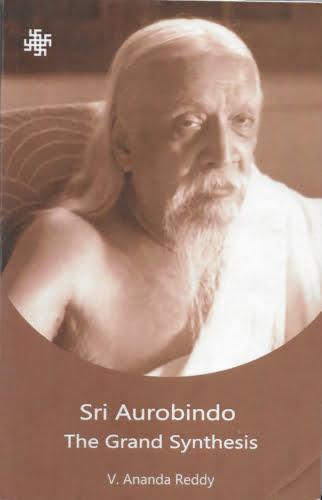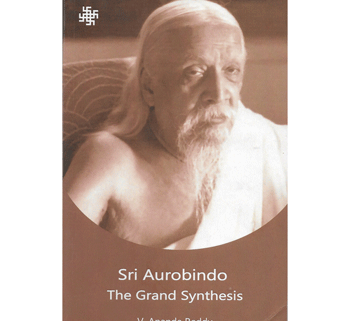Sri Aurobindo: The Grand Synthesis

Sri Aurobindo: The Grand Synthesis
On November 3rd, Dr. Ananda Reddy released his new book Sri Aurobindo: The Grand Synthesis at a function at Auroville’s Unity Pavilion in the presence of the Vice Chancellor of the Pondicherry University Prof. Gurmeet Singh and the Secretary of the Auroville Foundation Dr. Jayanti Ravi. The book is dedicated to Sri Aurobindo on the occasion of his 150th birth anniversary.
The book is divided into two parts. In part one, Ananda highlights the turning points in Sri Aurobindo’s life and explains why he considers Sri Aurobindo to be the guiding spirit of humanity. In the chapter Sri Aurobindo: The Future, he comments on each of the five dreams of Sri Aurobindo, given as a message for the 15th of August 1947 on the occasion of India’s independence.
“The dreams of a rishi are the milestones of humanity’s evolutionary march,” he writes and then assesses to what extent each of these dreams have been realised. The first dream was about a free and united India, which was only partly realized during Sri Aurobindo’s lifetime. But the unity between India and Pakistan that Sri Aurobindo had envisaged has not manifested, not even after 75 years of independence. “By whatever means, in whatever way, the division must go and will be achieved for it is necessary for the greatness of India’s future,” wrote Sri Aurobindo. The author briefly discusses the missed opportunities for unification of the past, and then touches upon the possibilities of a peaceful unification. “The economic boom and the cultural dynamism that are bursting forth on all the levels of Indian life are sure indications of the reawakening of India’s soul, and this itself is the assurance that the reunification of the two countries too will be worked out rather by her inner being than by any political party of selfish and narrow-minded political or social leaders,” he concludes.
Regarding the dream of the resurgence and liberation of the peoples of Asia and her return to the great role in the progress of human civilization, he observes that the dream has come true, but with the danger of the present expansionist policy of China. Commenting on Sri Aurobindo’s third dream of “a world union forming the outer basis for a fairer, brighter and nobler life for all mankind”, he sees the development of the European Union as a step in its manifestation but warns that, as Sri Aurobindo wrote, such a union based on continents might be standing in the way of world unity. The only way out, is that humanity in general turns to a psychological fraternity, or a oneness based on spirituality.
Ananda discusses Sri Aurobindo’s fourth dream, “the spiritual gift of India to the world”, in the context of The Mother’s statements that “India has become the symbolic representation of all the difficulties of modern mankind. India will be the land of its resurrection – the resurrection to a higher and truer life.” and that “India is the Guru of the world.” Linked to this is Sri Aurobindo’s fifth dream of “a step in evolution which would raise man to a higher and larger consciousness”, which, in fact, is the basis of all the other dreams. “For without the growth of a higher consciousness, all that Sri Aurobindo envisaged in his previous four dreams is not feasible,” writes Ananda. “It is because of its need in taking humanity to the next step in evolution, to the Superman, that India’s ancient wisdom will be revived in its depth and fullness and awaken the sense of spirituality in the general human consciousness.”
Part two of the book has four sections. In the section Sri Aurobindo’s Contribution to Humanity, Ananda highlights the stages of Sri Aurobindo’s literary output. In the section Sri Aurobindo’s Realisations, he briefly introduces the essence of each of Sri Aurobindo’s realisations as he has written them in The Life Divine, the Synthesis of Yoga, and the Essays on the Gita. In the third section, Spirit and Significance of Indian Culture, he discusses, The Secret of the Veda, the Isha Upanishad, The Renaisssance in India, The Human Cycle and The Ideal of Human Unity. In the fourth section he discusses The Future Poetry and Savitri – A Legend and a Symbol.
But what exactly comprises Sri Aurobindo’s Integral Yoga? “The Life Divine and the Synthesis of Yoga are incomplete. To complete this yoga, we have to add the 13 volumes of Mother’s Agenda and Savitri. All these books together form the whole of the Integral Yoga as envisaged by Sri Aurobindo,” writes Ananda.
The book ends with an Epilogue, Sri Aurobindo: The Grand Synthesis, in which Ananda takes us through a brief history of how Hinduism has unfolded through the ages: from the Vedic Age comprising the Vedas and Upanishads, to the Six Schools of Indian philosophy, to the Shastras and the Epics, to the Bhagavad Gita and then to the Purano-Tantrik Age. In each stage, a new level of spirituality was manifest; through of all this, he writes, the Indian spiritual psyche of the individual prepared itself for the next stage, which, in the words of Sri Aurobindo, “should render him capable of taking up his whole mental, psychical and physical living into a first beginning at least of a generalized spiritual life.” As Ananda writes, “The ancient spirit which descended from the Intuitive through the Illumined, the Higher Mind, Mind, Life and the Psychic has reached in Sri Aurobindo the Physical – the culmination of the descent.” For no full divine life on earth is possible without the physical transformation. This justifies the title of this book: for in Sri Aurobindo, Indian spirituality has reached its Grand Synthesis.
Sri Aurobindo: The Grand Synthesis
By Dr. Ananda Reddy
Published by the Indira Gandhi National Centre for the Arts
Available from SABDA
227 pages
Price in India Rs 285
Carel
the article was originally published
in “Auroville Today”


Leave a Reply
Want to join the discussion?Feel free to contribute!